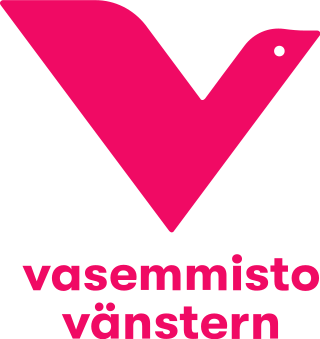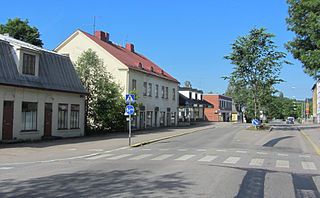
Helsinki is the capital and most populous city in Finland. It is on the shore of the Gulf of Finland and is the seat of southern Finland's Uusimaa region. About 682,000 people live in the municipality, with 1.26 million in the capital region and 1.6 million in the metropolitan area. As the most populous urban area in Finland, it is the country's most significant centre for politics, education, finance, culture, and research. Helsinki is 80 kilometres (50 mi) north of Tallinn, Estonia, 360 kilometres (220 mi) north of Riga, Latvia, 400 kilometres (250 mi) east of Stockholm, Sweden, and 300 kilometres (190 mi) west of Saint Petersburg, Russia. Helsinki has significant historical connections with these four cities.

The Left Alliance is a socialist political party in Finland.

The Finns Party, formerly known as the True Finns, is a right-wing populist political party in Finland. It was founded in 1995 following the dissolution of the Finnish Rural Party.

Kankaanpää is a town and municipality of Finland. Kankaanpää was founded in 1865, became a township in 1967 and finally a town in 1972. It is located in the crossroads of Hämeenkangas and Pohjankangas ridges. It belongs to the region of Satakunta. Kankaanpää has a population of about 12,500 inhabitants, which make it the third largest municipality in the Satakunta region in terms of population, after the city of Pori and the town of Rauma. Pori is located 53 kilometres (33 mi) southwest of Kankaanpää.

South Ostrobothnia is one of the 19 regions of Finland. It borders the regions of Ostrobothnia, Central Ostrobothnia, Central Finland, Pirkanmaa, and Satakunta. Among the Finnish regions, South Ostrobothnia is the ninth largest in terms of population. Seinäjoki is the regional centre and by far the largest city in the area.

Uusimaa is a region of Finland. It borders the regions of Southwest Finland, Tavastia Proper (Kanta-Häme), Päijänne Tavastia (Päijät-Häme), and Kymenlaakso. Finland's capital and largest city, Helsinki, along with the surrounding metropolitan area, are both contained in the region, and Uusimaa is Finland's most populous region. The population of Uusimaa is 1,734,000.

Karkkila is a town and a municipality of Finland.

Kontula is a quarter of Helsinki, Finland, part of the Mellunkylä neighbourhood. Kontula was built mostly in the 1960s and 1970s when more housing was required in Helsinki. Many people from the city centre moved to Kontula; due to its little higher than average concentration of government tenant housing complexes, immigrant and refugee population it is regarded as an average eastern Helsinki suburb.

East Helsinki is an area in Helsinki, Finland, usually thought to comprise the city's eastern and south-eastern major districts, including the districts of Vartiokylä, Myllypuro, Mellunkylä, Vuosaari, Herttoniemi, Laajasalo and Kulosaari. With the exception of Kulosaari, the buildings in the area are relatively new – most have been built in the 1960s or later – and constitute relatively densely inhabited suburbs, except for the southern part of Laajasalo and most of Kulosaari. On the other side of the bridge to the west of Kulosaari is Helsinki Downtown, the so-called "South Helsinki". Officially, the name "East Helsinki" is not found in the city's regional nomenclature, but it was a name created by the locals of the area.

Santahamina is an island and neighbourhood of Eastern Helsinki, Finland. At present it is a military base housing the Guard Jaeger Regiment, making access restricted. The Finnish National Defence University (NDU) is also located on the island.

Mellunmäki has been a quarter of eastern Helsinki, Finland since 1946.

Immigration to Finland is the process by which people migrate to Finland to reside in the country. Some, but not all, become Finnish citizens. Immigration has been a major source of population growth and cultural change throughout much of the history of Finland. The economic, social, and political aspects of immigration have caused controversy regarding ethnicity, economic benefits, jobs for non-immigrants, settlement patterns, impact on upward social mobility, crime, and voting behaviour.

Koskela is a district in the city of Helsinki, Finland. There are about 3 300 inhabitants. The borough is surrounded by Käpylä, Kumpula, Vanhakaupunki, and Oulunkylä. Koskela is located in the subdivision of Vanhankaupungin peruspiiri, near the rapids close to the mouth of the Vantaa River. The earliest mention of the human settlement in Koskela dates back to 1417, which makes it the oldest part of Helsinki.

Mellunkylä is a neighbourhood in East Helsinki, Finland. The area of Mellunkylä is 9,9 km2 and it has population of 36,360 (2005).

Jakomäki is a quarter, part of Suurmetsä neighbourhood in Helsinki, Finland. It has an area of 1.92 km2 and a population of 5,481 (2005).

Kurkimäki (Finnish), Tranbacka (Swedish) is an eastern neighborhood of Helsinki, Finland.

The cabinet of Juha Sipilä was the 74th government of Finland, from 2015 to 2019. It was formed following the parliamentary election of 2015 and formally appointed by President Sauli Niinistö on 29 May 2015. From June 2017, the cabinet consisted of a coalition formed by the Centre Party, Blue Reform and the National Coalition Party. The cabinet's Prime Minister was Juha Sipilä.

Parliamentary elections were held in Finland on 14 April 2019. For the first time, no party received more than 20% of the vote. The Centre Party, which had been the largest party following the 2015 elections, dropped to fourth place, losing 18 seats and recording its lowest vote share since 1917. The Social Democratic Party saw the biggest gains, winning six more seats and narrowly becoming the largest party for the first time since 1999. The Green League and the Left Alliance also gained five and four seats respectively.

Movement Now is an economically liberal political party in Finland.

Parliamentary elections were held in Finland on 2 April 2023 to elect members of the Parliament of Finland.





















